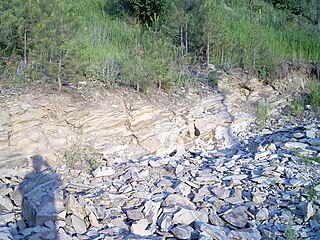
Trox is a genus of hide beetle in the subfamily Troginae.

Acanthacaris is a genus of deep-water lobsters. It contains two species, A. caeca and A. tenuimana, and is the only genus in the subfamily Neophoberinae.
Paleontology or palaeontology is the study of prehistoric life forms on Earth through the examination of plant and animal fossils. This includes the study of body fossils, tracks (ichnites), burrows, cast-off parts, fossilised feces (coprolites), palynomorphs and chemical residues. Because humans have encountered fossils for millennia, paleontology has a long history both before and after becoming formalized as a science. This article records significant discoveries and events related to paleontology that occurred or were published in the year 1879.

The Allenby formation is a sedimentary rock formation in British Columbia which was deposited during the Ypresian stage of the Early Eocene. It consists of conglomerates, sandstones with interbedded shales and coal. The shales contain an abundance of insect, fish and plant fossils known from 1877 and onward, while the Princeton Chert was first indented in the 1950's and is known from anatomically preserved plants.

Ulmus okanaganensis is an extinct species of flowering plant in the family Ulmaceae related to the modern elms. The species is known from fossil leaves, flowers, and fruits found in the early Eocene deposits of northern Washington state, United States and similar aged formations in British Columbia, Canada.

The Eocene Okanagan Highlands or Eocene Okanogan Highlands are a series of Early Eocene geological formations which span a 1,000 km (620 mi) transect of British Columbia, Canada, and Washington state, United States. Known for a highly diverse and detailed plant and animal paleobiota the paleolake beds as a whole are considered one of the great Canadian Lagerstätten. The paleobiota represented are of an upland subtropical to temperate ecosystem series immediately after the Paleocene–Eocene thermal maximum, and before the increased cooling of the middle and late Eocene to Oligocene. The fossiliferous deposits of the region were noted as early as 1873, with small amounts of systematic work happening in the 1870–1920s on British Columbian sites, and 1920–1930s for Washington sites. Focus and more detailed descriptive work on the Okanagan Highland sites started in the late 1960s.
Trox cadaverinus is a species of hide beetle in the subfamily Troginae. Within the genus Trox, it is placed in the core subgenus Trox.
Trox coracinus is a species of hide beetle in the subfamily Troginae. Within the genus Trox, it is placed in the core subgenus Trox.
Trox gansuensis is a species of hide beetle in the subfamily Troginae. Within the genus Trox, it is placed in the core subgenus Trox.
Trox horiguchii is a species of hide beetle in the subfamily Troginae. Within the genus Trox, it is placed in the core subgenus Trox.
Trox lama is a species of hide beetle in the subfamily Troginae. Within the genus Trox, it is placed in the core subgenus Trox.
Trox lutosus is a species of hide beetle in the subfamily Troginae. Within the genus Trox, it is placed in the core subgenus Trox.
Trox maurus is a species of hide beetle in the subfamily Troginae. Within the genus Trox, it is placed in the core subgenus Trox.
Trox mitis is a species of hide beetle in the subfamily Troginae. Within the genus Trox, it is placed in the core subgenus Trox.
Trox placosalinus is a species of hide beetle in the subfamily Troginae. Within the genus Trox, it is placed in the core subgenus Trox.
Trox stellatus is a species of hide beetle in the subfamily Troginae. Within the genus Trox, it is placed in the core subgenus Trox.
Trox torpidus is a species of hide beetle in the subfamily Troginae. Within the genus Trox, it is placed in the core subgenus Trox.
Trox ussuriensis is a species of hide beetle in the subfamily Troginae. Within the genus Trox, it is placed in the core subgenus Trox.
Trox confluens is a species of hide beetle in the subfamily Troginae. Within the genus Trox, it is placed in the subgenus Granulitrox. Though this species is disputed, with some taxonomists arguing T. confluens is merely a duplicate of Trox granulipennis, the general consensus is that T. confluens and T. granulipennis are distinct. This beetle lives in Algeria, the Canary Islands, Libya, Morocco, and Tunisia.

Ulmus chuchuanus is an extinct species of flowering plant in the family Ulmaceae related to the modern elms. The species is known from fossil leaves and fruits found in early Eocene sites of northern Washington state, United States and central British Columbia, Canada.






